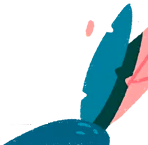
Top 5 tips for a beginning artist
Don’t see any progress in art despite long hours of practice? The issue is likely not an absence of talent, but perhaps in the wrong approach. No need to panic, it’s easy to manage. We have compiled the top 5 tips for you to avoid frustration in the process of learning to draw.
1. Boost your skills one at a time
Your general drawing skill consists of many different skills and aspects. Let’s suppose you have decided to draw a cat; in an hour, you shifted to a landscape, and some time later, you decide to draw a sectional view of a spaceship. Notably, you may not be pleased with any of these cases. That happens because you try to have it all immediately. Quality matters much more than quantity. Wise people say that particular parts of our brains are responsible for distinct activities. Thus, as soon as you’re on a new task and learn to perform it, new neural links are created in your brain. The more time you dedicate to a particular task, the more stable your neural connections become, forming a new skill. That’s why skills to which we dedicate more time are learned more successfully than those performed sporadically. A violinist plays a complex melody by heart; a ballet dancer performs unthinkable jumps and pirouettes, and a woodcutter creates masterpieces in seconds. So, bring your cat to perfection first, and proceed to the spaceship afterward.
2. Imaginative drawing
Drawing correctly by using only your imagination is possible, but can be done only after you train to draw the same object, looking at different references, understanding it, and studying its perspectives. So, we study the rules first, get the feel of it, and then proceed to imaginative drawing.
3. The cat is out of the bag
It sometimes happens that a part of the drawing is not right - a wrong perspective of the body, wrong head size, or some other difficulty. No need to conceal that, just start anew. In digital drawing, you can save separate body parts on different layers, so that they can be easily edited at any moment. In traditional art, try to preserve your initial sketches, drawing the final concept separately so that you always have a chance to discard an unsuccessful variant and return to your initial idea.
4. Other people’s opinions
Don’t be afraid of negative feedback on your works by presenting them online. How can you succeed, after all, without learning from feedback? Still, some ugly, inadequate comments should not pull the carpet from under you. You can even disable the comment section if a situation gets out of control.
There is always the other side of the coin, however. Your audience may like some types of content and praise it actively. But deep inside, you may feel the need to experiment and try something new, instead of posting cliché art for the sake of earning likes. Listen to your intuition and do what is interesting to you. Trends come and go, so it’s vital not to follow them blindly, but to develop and enjoy your craft.
There is always the other side of the coin, however. Your audience may like some types of content and praise it actively. But deep inside, you may feel the need to experiment and try something new, instead of posting cliché art for the sake of earning likes. Listen to your intuition and do what is interesting to you. Trends come and go, so it’s vital not to follow them blindly, but to develop and enjoy your craft.
5. Don’t cut corners on your work!
Inking photos is cool, but only if you’re honing the skill of inking :). Don’t do it for years. If you really want to develop in art, then embark on really complex tasks to expand your horizons. Today you may fail, but tomorrow the drawing will look better, while in a month, you’ll be proud of yourself and your products. Don’t stop, go ahead!
Come to the Digital Drawing side and create the Mandalorian with mentor Bryant Koshu!
During the workshop, you’ll learn how to search for references, use Photoshop and Procreate tools, make quick sketches, work with volume, light, shadow, and much more.
During the workshop, you’ll learn how to search for references, use Photoshop and Procreate tools, make quick sketches, work with volume, light, shadow, and much more.




ArtCraft has been bringing creative people's dreams to life since 2016. We teach digital art, 2D and 3D graphics, and animation to beginners from square one. Advanced students can upgrade their skills to further their future careers in the video game industry.

MENU
FOLLOW US
272 Bath Street, Glasgow
United Kingdom, G2 4JR
United Kingdom, G2 4JR
Phone: +442080896841
© ArtCraft Education LLP 2020
— All rights reserved
— All rights reserved


